15 Incredible Photos from 2023 Milky Way Photographer of the Year
![]()
Travel and adventure photography blog Capture the Atlas has announced the winners of its sixth annual Milky Way Photographer of the Year contest.
The collection of winning images showcases the incredible Milky Way nightscape photography of 25 photographers from 16 different countries. The final winning 25 shots were selected from over 3,000 entries.
“The quality of the image, the story behind the shot, and the overall inspiration that the photograph can provide are the main factors for selecting the images every year,” explains Capture the Atlas.
13 of PetaPixel’s Favorites
All 25 featured images are available on Capture the Atlas, but below is a selection of 10, alongside information about the photographer, location, and a short description provided by each photographer.
‘Cafayate Star Factory’ by Gonzalo Javier Santile
“To capture this shot, I arrived before the blue hour, and as soon as the first stars appeared, with some light still shining on the landscape, I took the images for the foreground. After that, when it was completely dark, I shot the vertical photos of the sky,” explains Santile.
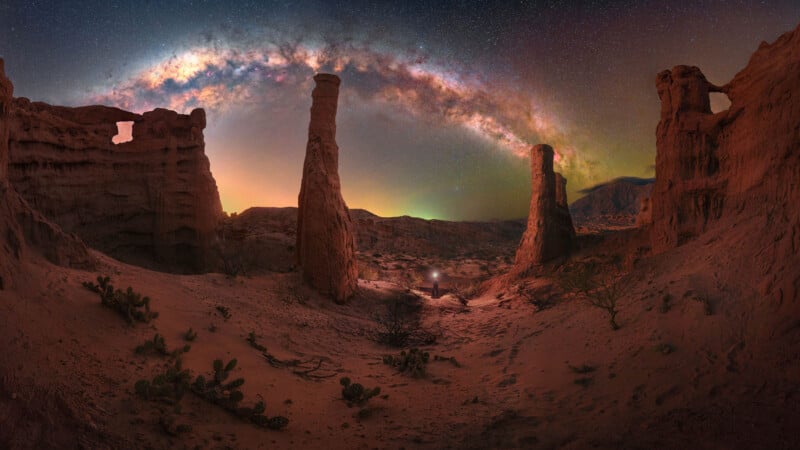
He used an astro-modified Nikon D750 camera with a Tamron 15-30mm f/2.8 zoom lens. The modified camera helped capture the reddish colors in the Milky Way. The sky was captured over a period of 43 seconds with the aid of a star tracker.
‘Gigi Hiu Shining in the Dark’ by Gary Bhaztara
“I’ve visited this spot more than 30 times; now it just feels like home,” says Bhaztara.
Gigi Hiu Beach is located in a rural part of Sumatra Island in Indonesia. “When shooting at this location, I have to make sure the tide conditions are perfect because the waves coming from the Indian Ocean can be big and crash hard against the coast, which can be dangerous,” Bhaztara adds.
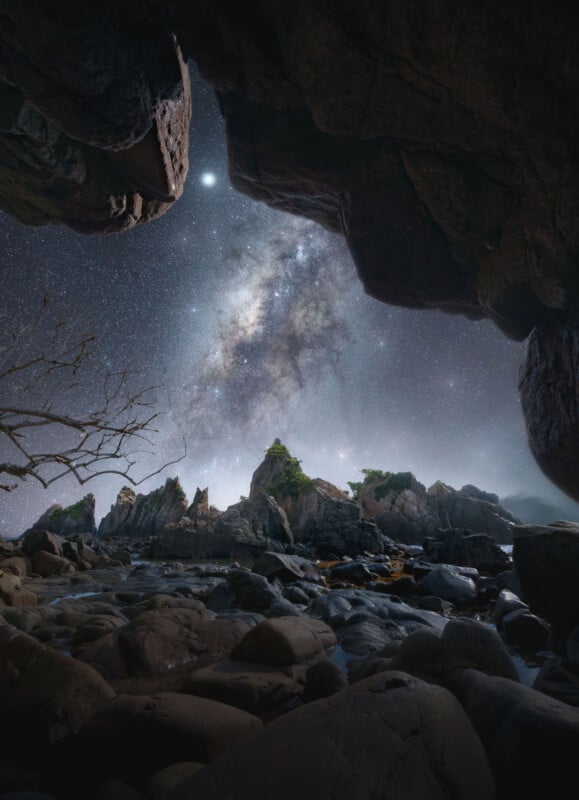
‘Interstellar’ by Jose Luis Cantabrana Garcia
“I had dreamed of visiting this location ever since I saw the breathtaking images captured by Michael Goh, also known as ‘Astrophotobear,’ whose work has also been featured as part of this contest in previous years,” says Garcia.
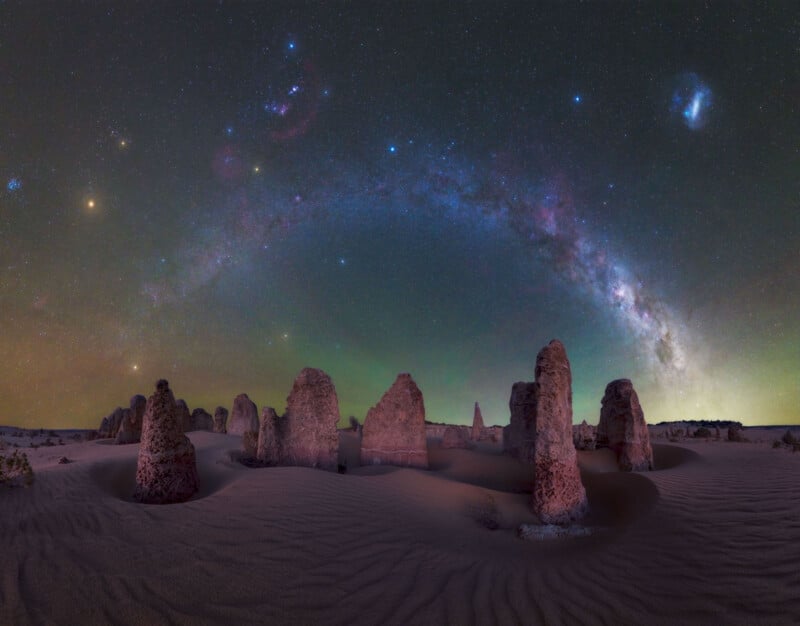
The Pinnacles Desert in Australia is a beautiful destinate that Garcia has long wanted to visit.
“This area is sacred to the Noongar people, the traditional owners of this land, and in the past, it was only accessible to women. The story goes that these limestone rocks are nothing but petrified ghosts of the men who dared to enter and were then eternally punished by the gods,” he says of the location.
‘Lut Glow’ by Isabella Tabacchi
Tabacchi captured this shot in Lut Desert, Iran, using a Hasselblad X1D II and XCD 30mm lens. It’s unusual to see night sky photos captured using medium format cameras like the X1D II.
“This is a rock formation in the Lut desert in Iran under the Milky Way. We spent the whole night, from sunset to sunrise, taking photos of that incredible sky. I was able to capture a green airglow under the Milky Way, behind the impressive rock formations in the warmest place on Earth,” Tabacchi explains.
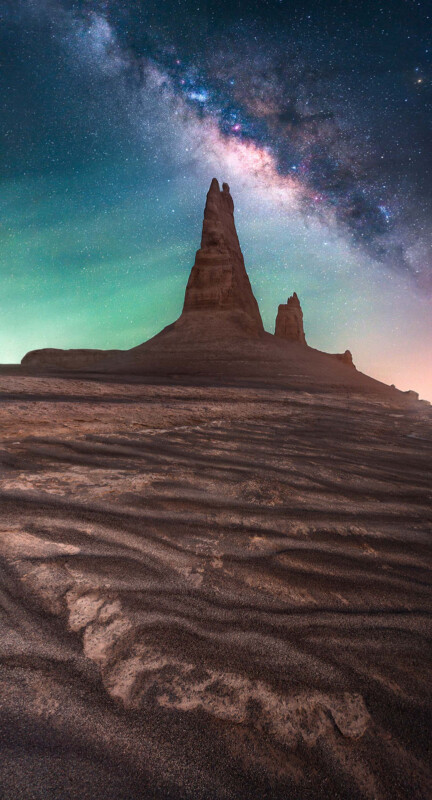
‘Milky Way Over Cuenca’s Hoodoos’ by Luis Cajete
“One of my passions is capturing large panoramas through night photography. Living in a big city, I have always battled against intense light pollution. That’s why I’ve spent years searching for places where I can truly appreciate the beauty of the stars. Witnessing the arc of the Milky Way is an absolutely awe-inspiring experience,” explains Cajete.
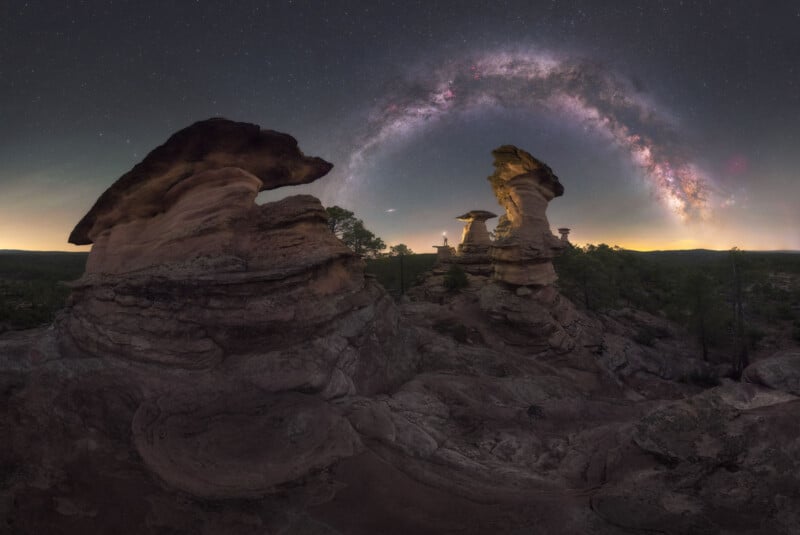
He scouted the location during the day, searching for an area with an intriguing and dynamic foreground. Using an iOptron SkyGuider Pro, Cajete captured a two-minute exposure of the sky.
‘Milky Way Rising Over Stony River and Mt. Taranaki’ by Brendan Larsen
“Getting the Milky Way lined up over Mount Taranaki in New Zealand from this location in early March meant a late night as it didn’t line up until 2:30 in the morning, but I was keen to make the most of the perfectly clear skies on that night,” Larsen says.
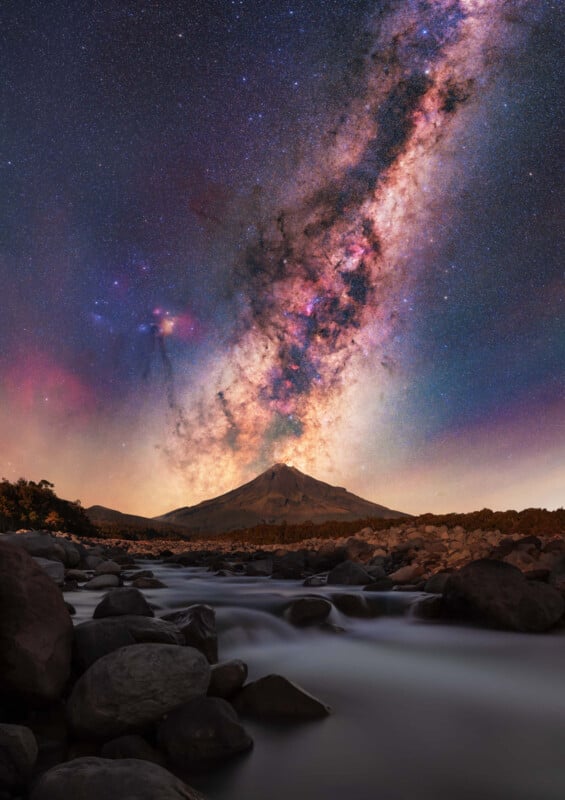
“I’m really pleased with how many colors I was able to capture with my camera, filters, and long exposures. Rho Ophiuchi in Scorpius looks really good with its pink, yellow, and blue colors, along with the Zeta Ophiuchi Nebula (the pinkish nebula to the lower left of the image came out well too). On the lower right of the image, there’s some nice airglow, which adds to the beauty and uniqueness of the sky that night,” he adds.
‘Night Under the Baobab Trees’ by Steffi Lieberman
This excellent panorama from Madagascar shows the area’s traditional baobab trees beneath a beautiful Milky Way arc.
“This photo means a lot to me, and I can’t even begin to tell you how difficult it was to take it. From the road conditions to the armed security guards protecting you while you take photos, everything about it was an adventure,” Lieberman explains.
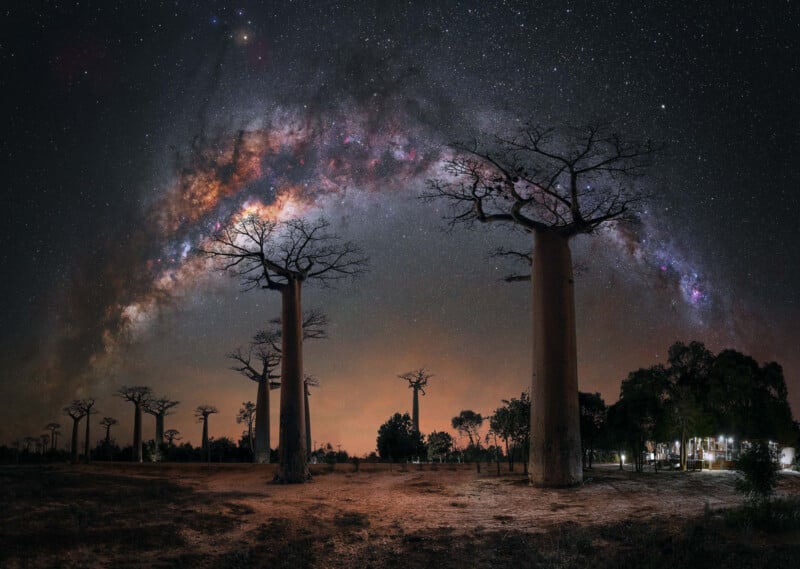
‘South of Home’ by Lorenzo Ranieri Tenti
“My journey to Namibia, particularly the Erongo area, was an extraordinary adventure, immersing me in the captivating beauty of the southern night sky. The panoramic photograph captures the breathtaking scene in the Gross Spitzkoppe Nature Reserve, where the southern Milky Way gracefully spans a remarkable formation of smooth granite boulders. This area holds a unique charm, with Mount Spitzkoppe being the sole prominent feature for kilometers, majestically rising 700 meters above the endless savannah,” Tenti explains.
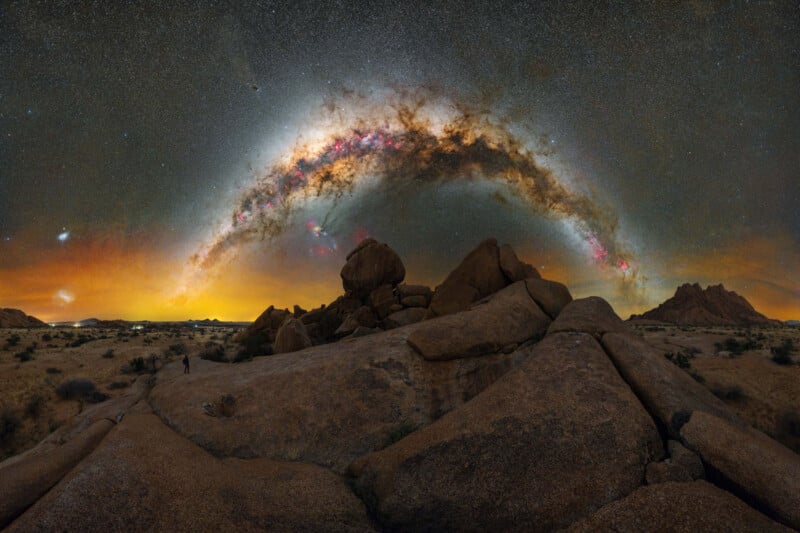
Lorenzo combined an exposure of the sky at 35mm and a foreground shot at 20mm into the final composite image. The sky was shot using an astro-modified Sony a7S, while the foreground was captured using a Sony a7 IV.
‘The Cactus Valley’ by Pablo Ruiz García
Garcia captured this photo during his first trip to photograph the Milky Way in the southern hemisphere. The photo, captured in Atacama, Chile, shows brilliant colors and detail.
“The photo I’m sharing with you was taken in the Cactus Valley, a stunning area of the Atacama Desert where it’s easy to compose photos with the night sky. I managed to include both nebulae, along with the iconic cacti of the valley,” says García.
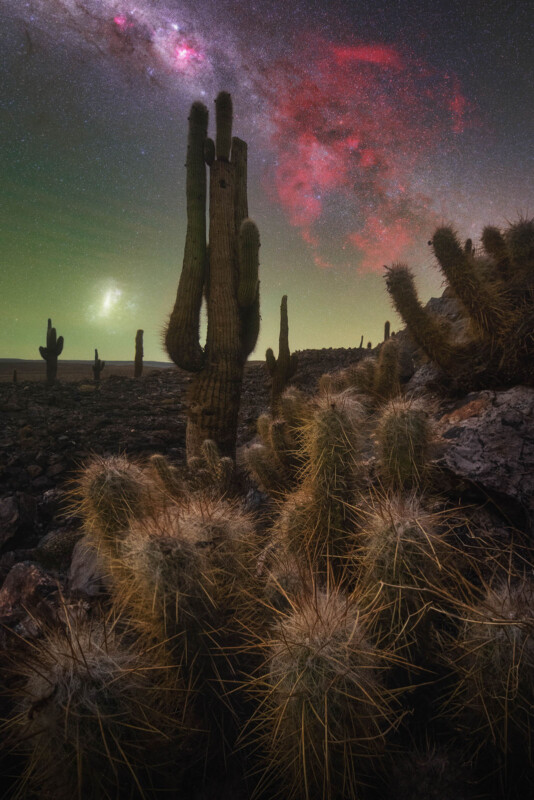
‘The Cathedral Light Show’ by Roksolyana Hilevych
This excellent photo combines a brilliant night sky, dynamic landscape, and beautiful flowers, and a fortuitous meteor.
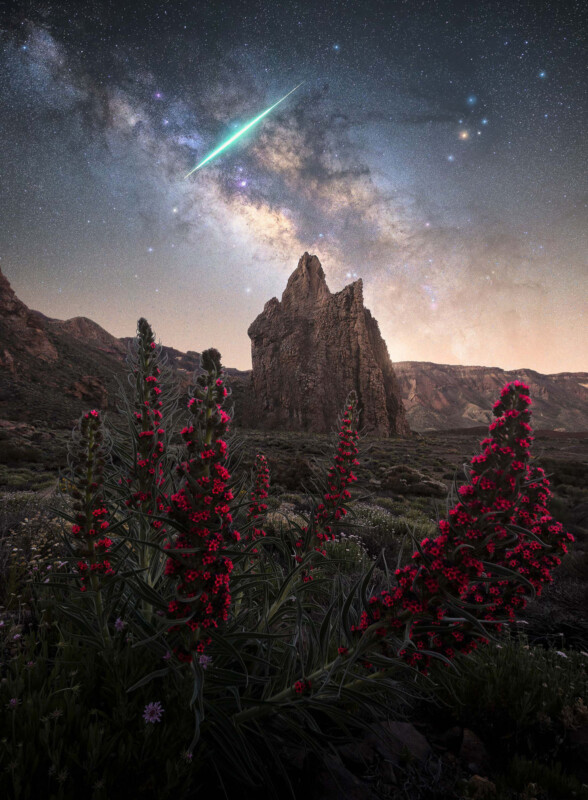
“Sometimes it takes a bit of luck. This was definitely the best moment I’ve ever had during a nighttime session; this only happens once in a lifetime. However, I really hope to be able to see the fireball again someday!” says Hilevych.
“It was the first and only time I saw such a bright meteor. It lit up everything around it, making it seem like daytime for a few seconds. Luckily, at the moment it appeared, I was photographing the core of the Milky Way,” Hilevych adds.
‘The La Palma Astroexperience’ by Jakok Sahner
Another shot from Spain shows La Palma and the Canary Islands beneath a breathtaking night sky.
“On the first night of the trip, I was exhausted from a long journey and no sleep, but I couldn’t resist going out to capture the clear sky, as it was the first time I’ve experienced this much cloud cover. However, I would caution that exploring the terrain at night can be dangerous and should only be done by those familiar with it,” Sahner explains.
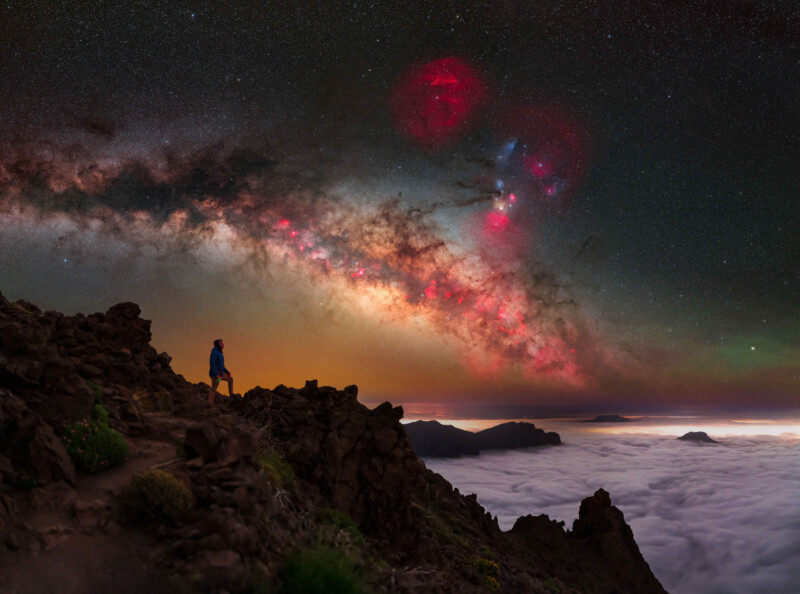
‘The Night Train’ by Alexander Forst
Combining incredible nature and a touch of humanity is an interesting juxtaposition.
“I photographed the night train last September at the Wiesener Viaduct. This photo is from a series of bridge photos that I started two years ago,” says Forst.
“Stopping movement is a common thing in photography. It is not as common in night photography, where movements become long, abstract lines due to the long exposure time. Two years ago I started experimenting with the stillness of moving objects in night photography and came up with a technique to make that possible. I photographed the train during the blue hour and the lights of the train at night,” Forst explains.
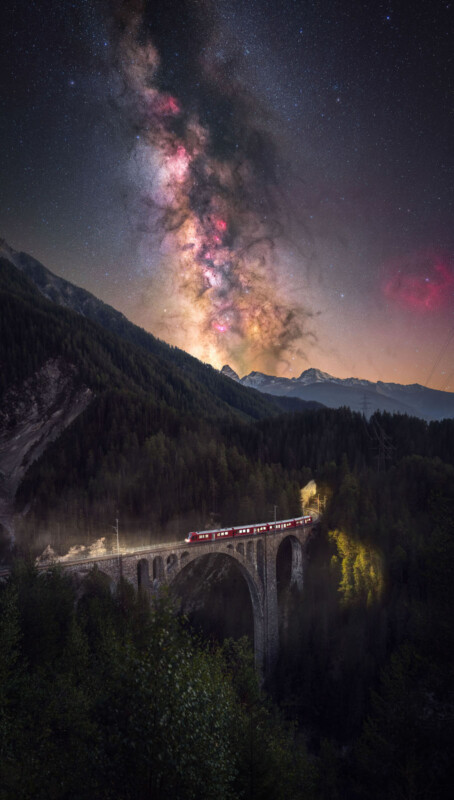
He continues, “When photographing complex projects like this, order is very important. After setting up the equipment and finding the right perspective, the first thing I had to do was photograph the train; then, when night fell, the foreground and the lights of the last train; and finally, the Milky Way. I then put the pictures in Photoshop overlaid with the rest of the foreground and Milky Way shots.”
‘The Scenery I Wanted to See’ by Mitsuhiro Okabe
This shot screams “Japan,” featuring quintessential scenery including a temple and Mt. Fuji, during cherry blossom season.
“Mount Fuji, Japan’s iconic symbol, dominates the backdrop of this image, set during cherry blossom season. Amidst the landscape, you can see a sacred temple dedicated to honoring the spirits of the departed. And there, against the dark canvas of the night sky, the ethereal beauty of the Milky Way came into view,” Okabe explains.
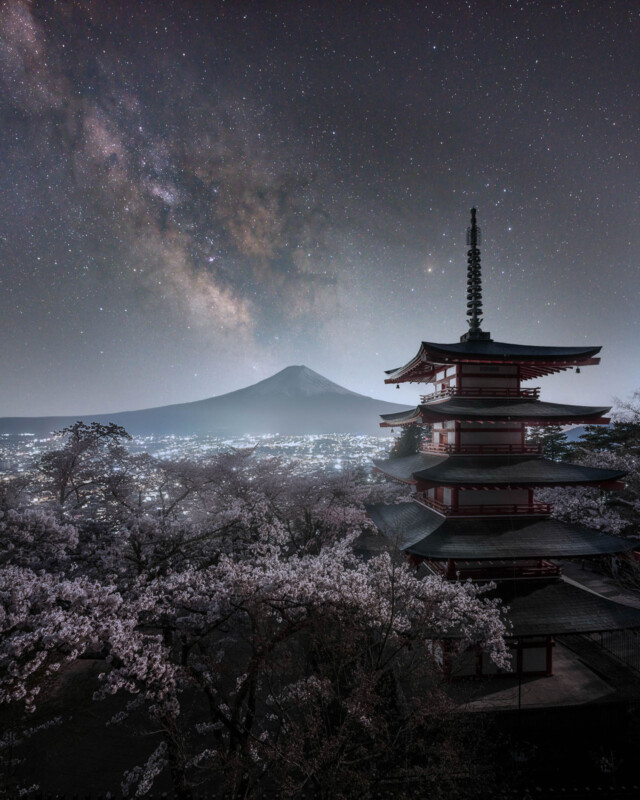
A Pair of Familiar Photos
‘The Bottle Tree Portal’ by Benjamin Barakat
This image has previously been featured on PetaPixel as part of an article about Benjamin Barakat’s extraordinary trip to the remote island of Socotra in Yemen.
“Nights on the mystical island of Socotra are unforgettable, especially under the embrace of the most alien-looking and beautiful trees I have ever seen. Their gnarled and twisted trunks seemed to tell stories of ancient times while the blooming pink flowers added a touch of ethereal beauty,” Barakat explains.
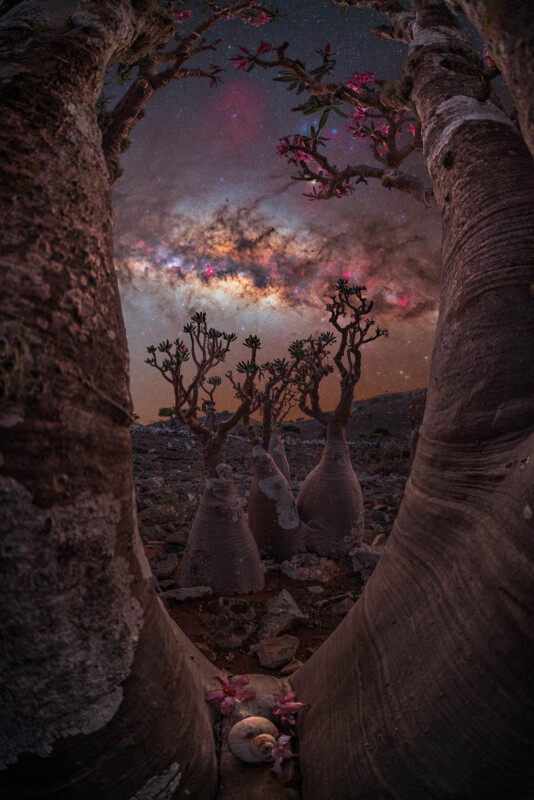
‘The Eyes of the Universe’ by Mihail Minkov
Another image featured recently on PetaPixel is Mihail Minkov’s astonishing Milky Way panorama.
The time-blended image shows a pair of Milky Way arches captured hours apart on the same evening.
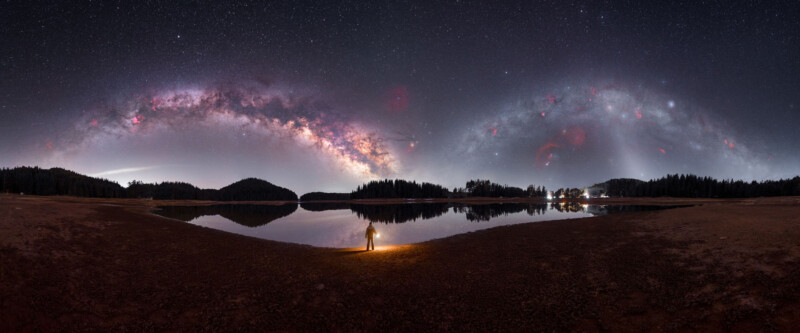
“I’ve always wondered what the night sky would look like if we could see the two Milky Way arches from the winter and summer side by side. This is practically impossible, since they are part of a whole and are visible at different times of the day,” Minkov explains.
Tips for Photographing the Milky Way
Alongside featuring the incredible winning photos in this year’s contest, Capture the Atlas also offers a guide full of tips for photographing the Milky Way, preparing photographers for next year’s contest. The guide includes practical tips, gear recommendations, and a helpful viewing chart.
“In the northern hemisphere, the Milky Way season starts in February and ends in October. You’ll find the best months to photograph the Milky Way between May and August,” explains Capture the Atlas. In the southern hemisphere, the Milky Way season is from January to November, with the best months being between April and August. Photographers can capture great shots of the Milky Way all year, but the “Milky Way season” is when its beautiful galactic center is visible.
PetaPixel has also published numerous guides to help photographers plan and capture amazing Milky Way photos, including “How to Photograph the Milky Way” and “How to Photograph the Milky Way: The Preparation.”
Image credits: All photos are individually credited and provided courtesy of Capture the Atlas.